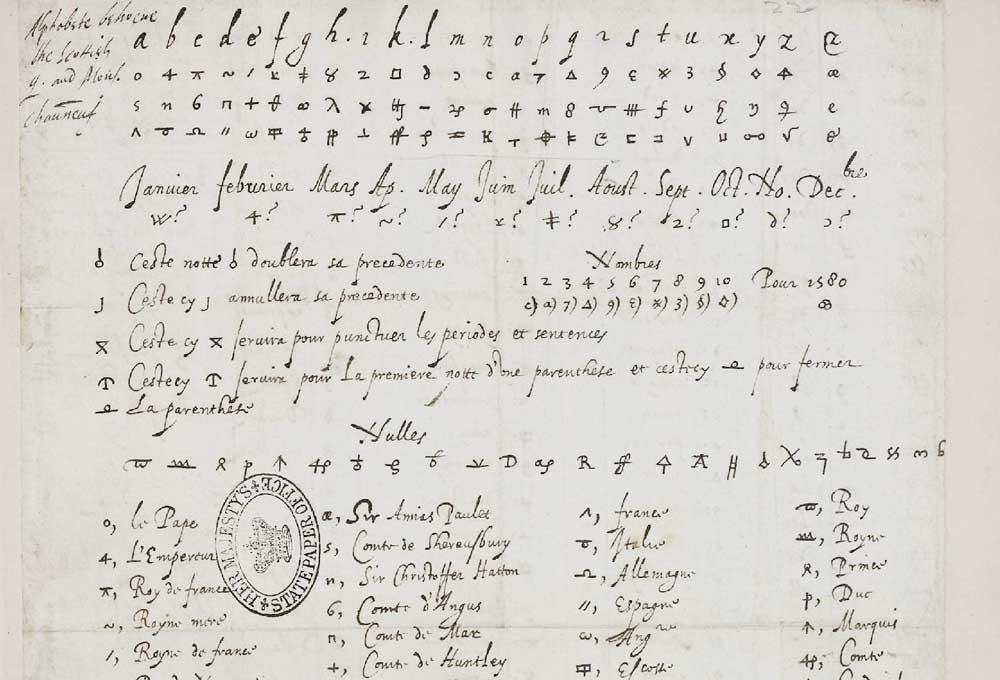Codes and Crowns | History Today - 5 minutes read

Mary, Queen of Scots was a prolific letter-writer. Thousands of her letters survive in collections across the world, in languages including French, English, Scots, Latin and, most intriguingly, in cipher. While interest in Mary remains undimmed, there is no modern edition of her correspondence. Largely, this is due to the challenges of such a corpus. After her death it was found that she used more than 100 different ciphers in her correspondence. It is also true that she sent many hundreds more letters that may not survive, which we can deduce from references in surviving letters, though rarely do we manage to locate them.
However, 57 letters have been deciphered for the first time since their composition over 400 years ago, allowing their attribution to Mary. The letters date from 1578-84 and are mostly from Mary to Michel de Castelnau, Sieur de la Mauvissière, the French ambassador to England (1575-85). The letters, held at the Bibliothèque nationale de France, had been catalogued as enciphered messages, but, since the sender and the recipient were unknown, they had been archived alongside other manuscripts that related to Italian affairs. It is only through this new decipherment by George Lasry, Norbert Biermann and Satoshi Tomokiyo that we know the letters were in fact from Mary, Queen of Scots.
Their project relied upon a combination of manual research and computerised cryptanalysis. This identified the plaintext language as French, not Italian as earlier records had assumed, and from there a series of increasingly complex decipherment was achieved, moving from recognising single letters of the alphabet through to identification of prefixes, words and individual names. The researchers benefited from an understanding of early modern epistolary form and function; noting, for example, that a standard closing formula for letters in the period was to end with the place of writing and the date, they were able to decipher the symbols for all 12 months of the year and several locations including London and Sheffield.
Ciphers generally disguised each letter with a single symbol, but to enhance security homophones were used – that is, multiple symbols could be used to represent the most common letters. Common words could also be disguised by symbols specifically used to represent months, places and people’s names. A final level of obfuscation would be introduced by red herrings or ‘nulls’, which those in the know would ignore. Usually, the symbols employed in ciphers were a mix of letters from other alphabets, such as Greek or Arabic, and graphical shapes, though some contemporaries like William Cotton, an English Catholic exile, created ciphers based on an arbitrary shape which had minute differences to indicate different syllables.
The contents of these letters are a mix of political discussion and personal complaint, a theme we see across Mary’s letters. Unsurprisingly, she is scathing about those she views as enemies. She warns that Sir Francis Walsingham is not to be trusted and that the Puritan faction at court in England are plotting against her. Generally, however, the letters do not include explicit intelligence regarding events such as the Throckmorton Plot of 1583. Though we might find this surprising – we expect ciphered text to be ‘dangerous’, hence the disguise – the content is entirely in keeping with Mary’s circumstances. By 1580 she was increasingly isolated from her son and her French relatives had begun to die, leaving her with fewer intimate connections to rely upon. The letters therefore reflect Mary’s shifting strategies as her imprisonment dragged on. She writes often about negotiations for her release, based upon her willingness to give up claims to the English throne. This change in approach, which she had long fought against, seems also in part due to the deterioration of her personal circumstances. Her finances were becoming more difficult to access meaning she was struggling to reward servants and supporters, while her health suffered from lack of exercise, poor ventilation in her rooms and recurrent bouts of physical and mental illness. Rather than offering salacious new information then, these letters are more informative about how Mary maintained links with supporters even during the intense surveillance of her imprisonment.
The new letters have also helped to confirm a long-held suspicion that there was a mole in the French embassy who successfully passed letters to the English. Between 1576 and 1579 there are few surviving letters to Mauvissière, both in the newly deciphered collection and elsewhere. In 1578, Mary herself complained that she had not received any letters from him for many months. The numerous letters from 1582-83 on the other hand suggest that a reliable route of transmission had been established and the survival of both ciphered letters and contemporary plaintext copies in English archives indicates the success of the mole throughout 1584.
Hundreds of other ciphered letters might now reveal their secrets. Many of Mary’s newly deciphered letters also referred to enclosures that she asked Mauvissière to forward on to other correspondents, which he seems to have done. These enclosed letters have not yet been identified, but we might now have the tools to find them if they survive. Code names for prominent figures and letter-bearers that have been identified here could also be applied to more of Mary’s letters, revealing new details. And there may be other letters waiting quietly to have their sender revealed as Mary. Further research to identify whether Mary designed the ciphers herself, in collaboration with secretaries and supporters, or whether they reflect a common style of the period, might allow a reassessment of incriminating documents such as those used at her final trial. Could we finally be able to see whether Mary really did agree to Elizabeth’s assassination as part of the Babington Plot of 1586? Only time, and more innovative research, will tell.
Jade Scott is Lecturer in Historical Linguistics at the University of Glasgow.
Source: History Today Feed